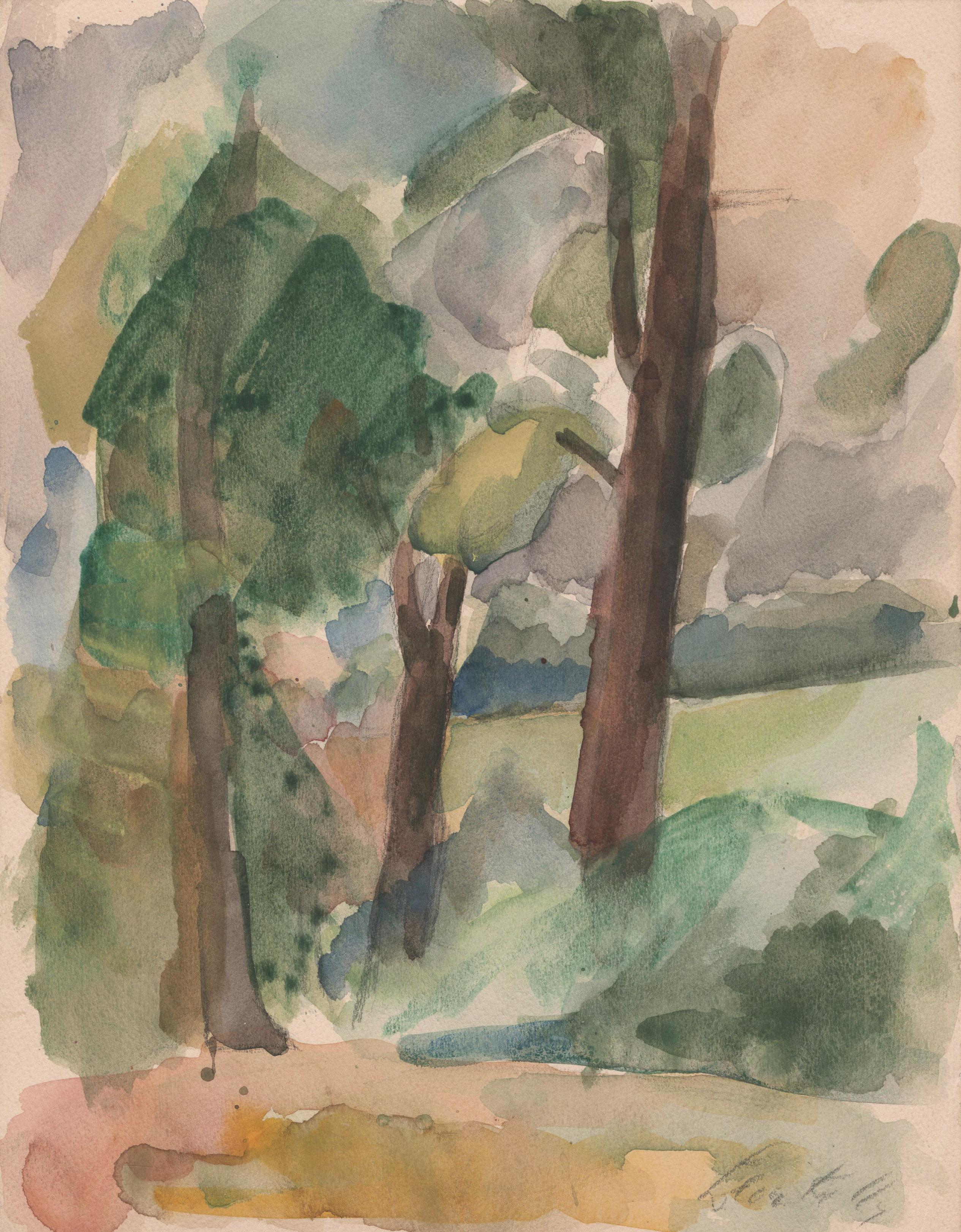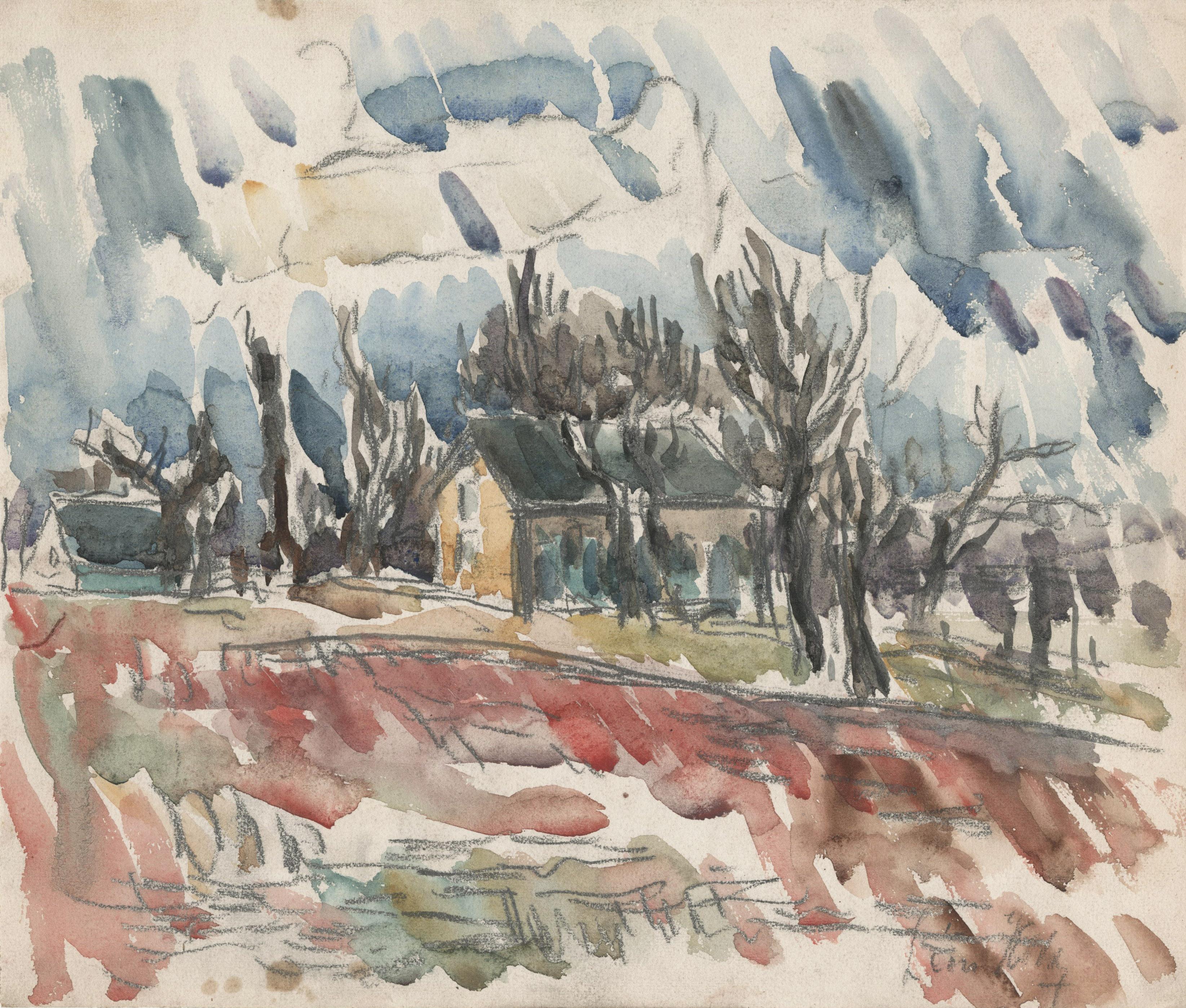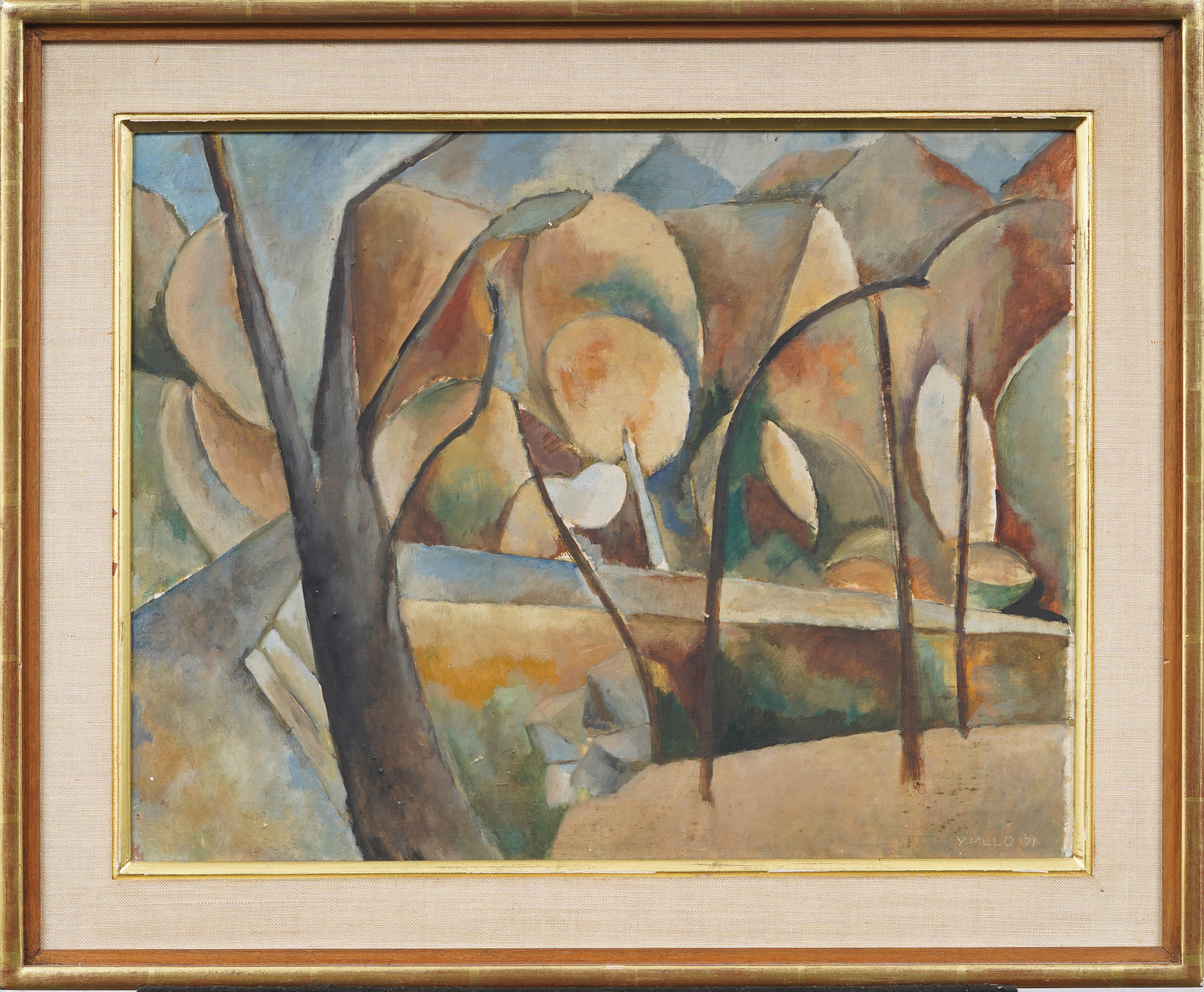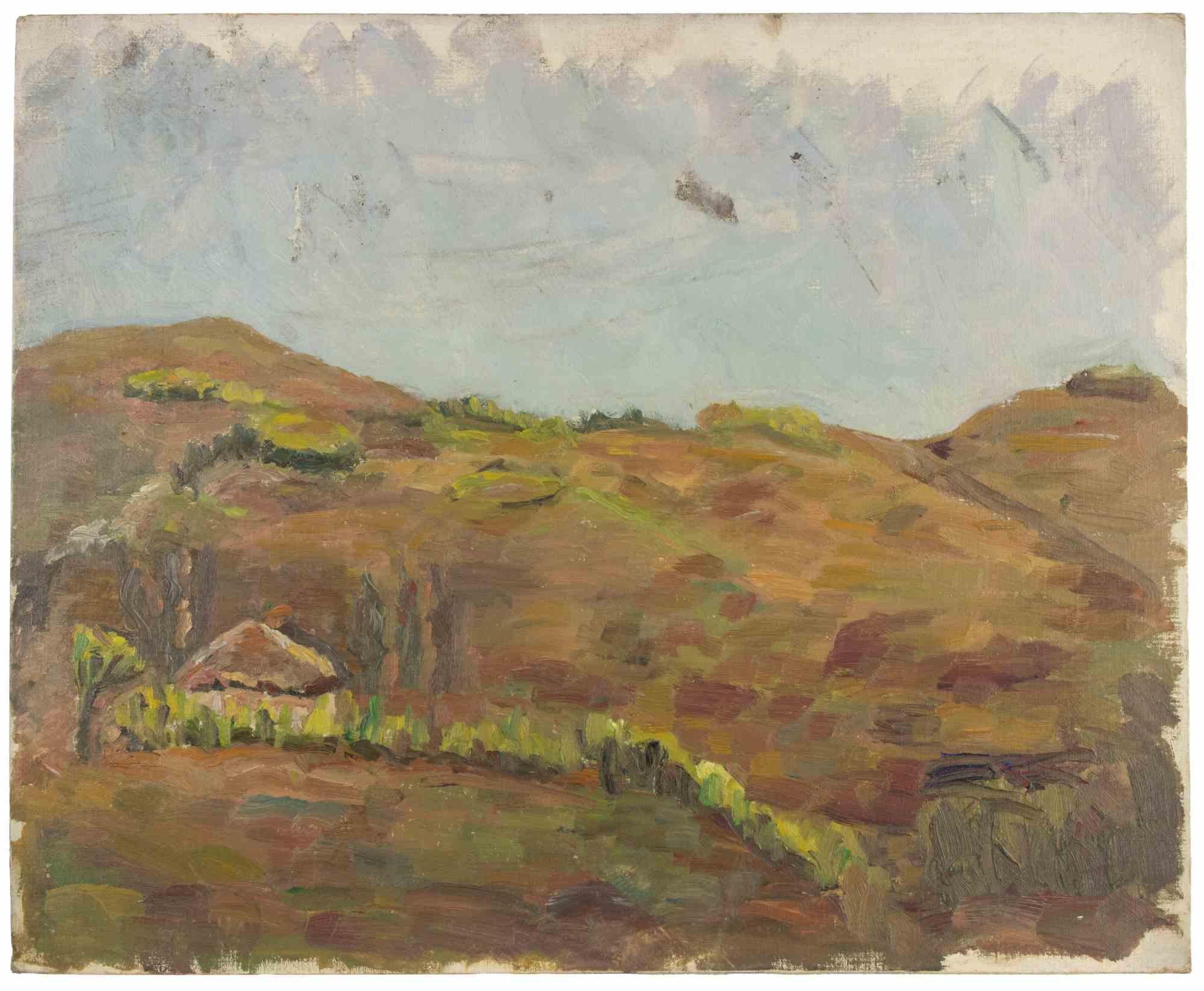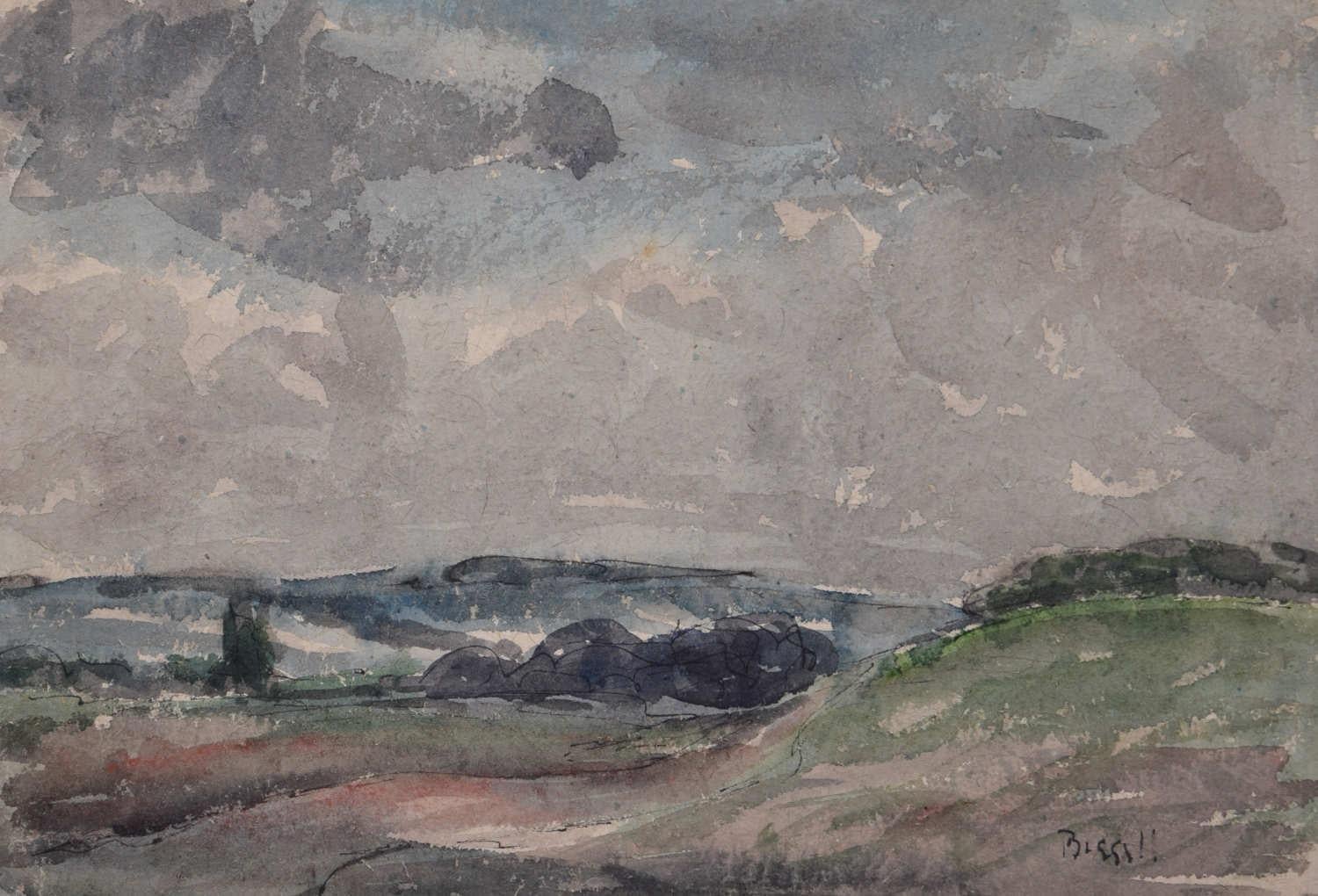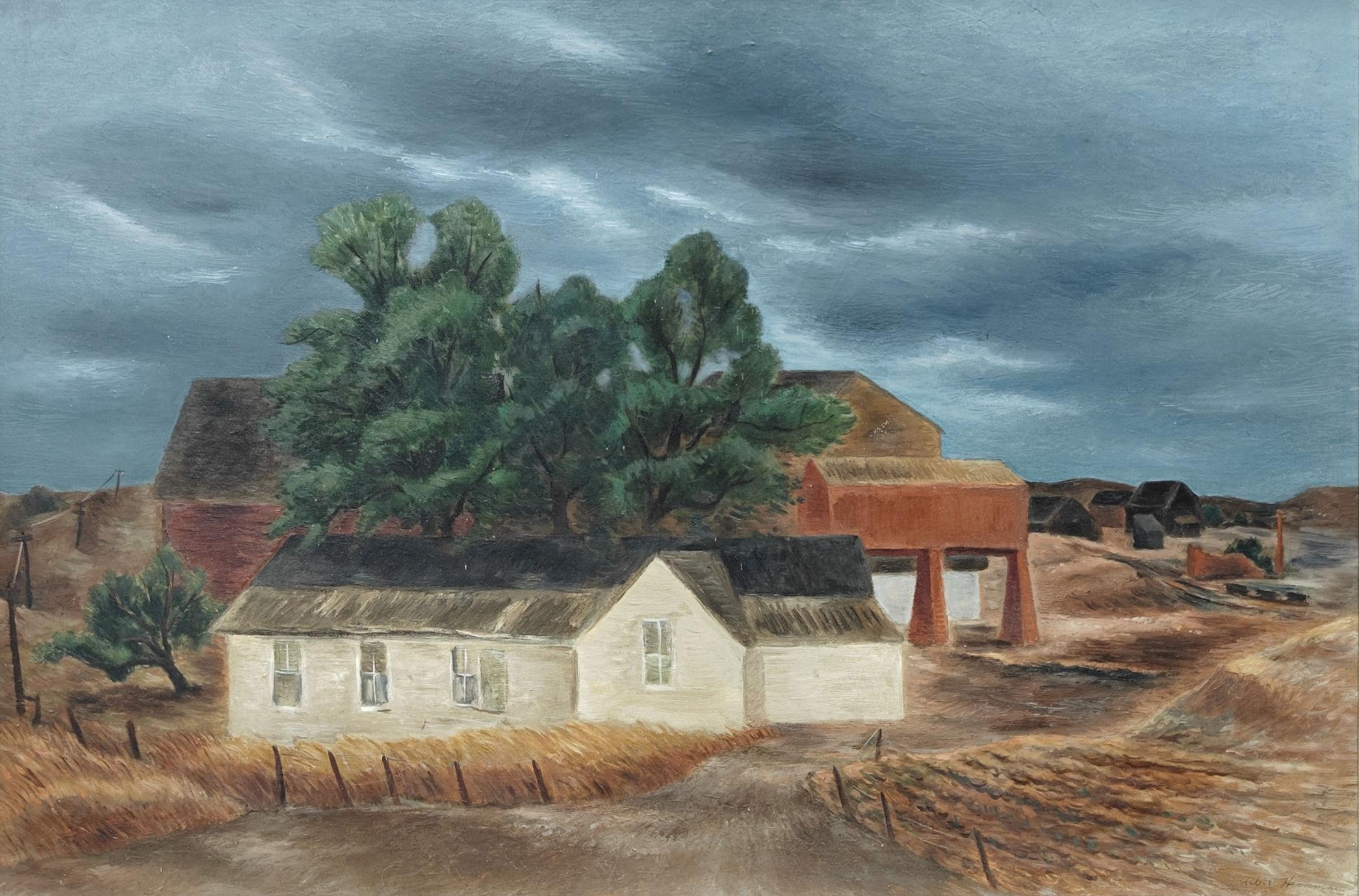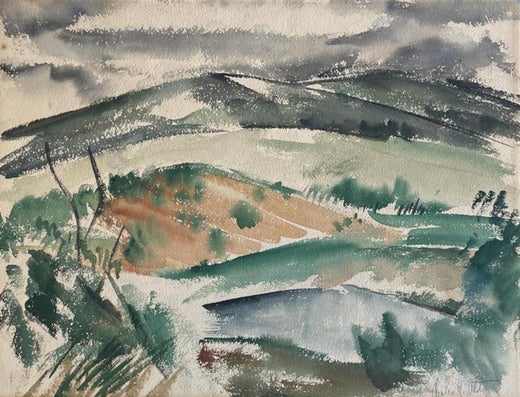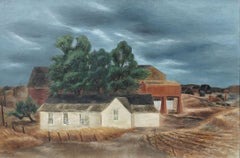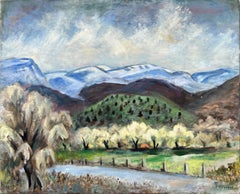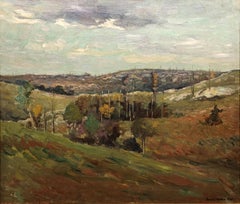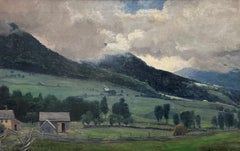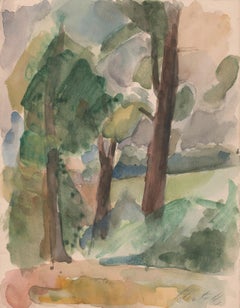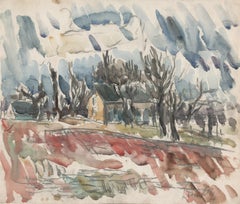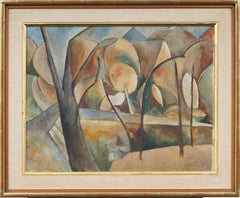Items Similar to "Landscape with Hills" Charles Alston, Harlem Renaissance Modernist Landscape
Want more images or videos?
Request additional images or videos from the seller
1 of 8
Charles Alston"Landscape with Hills" Charles Alston, Harlem Renaissance Modernist Landscape
$7,600
$9,50020% Off
£5,766.71
£7,208.3820% Off
€6,593.71
€8,242.1420% Off
CA$10,615.14
CA$13,268.9220% Off
A$11,802.59
A$14,753.2420% Off
CHF 6,162.66
CHF 7,703.3320% Off
MX$143,666.27
MX$179,582.8320% Off
NOK 78,632.88
NOK 98,291.1020% Off
SEK 73,675.25
SEK 92,094.0620% Off
DKK 49,210.08
DKK 61,512.6020% Off
Shipping
Retrieving quote...The 1stDibs Promise:
Authenticity Guarantee,
Money-Back Guarantee,
24-Hour Cancellation
About the Item
Charles Alston
Landscape with Hills
Signed lower right
Watercolor on paper
13 1/2 x 18 1/4 inches
Charles Henry Alston was an influential painter during the Harlem Renaissance and the first African American supervisor for the Works Progress Administration. He supervised the WPA murals created at Harlem Hospital, leading a staff of 35 artists and assistants. Alston was also the first African American to teach at both the Museum of Modern Art and the Art Students League and, in 1969, to have been appointed the painter member of the Art Commission of the City of New York.
Alston was born in Charlotte, North Carolina, and was related to renowned artist Romare Bearden through his mother's second marriage. He attended Columbia University as an undergraduate and graduate student, receiving a B.A. from Columbia College in 1929 and an M.F.A. from Columbia University's Teachers College in 1931. After graduating he worked at the Harlem Arts Workshop, and when the program required more space, he secured an additional facility at 306 W. 141st St. The space, known as "306," became a center for the Harlem art community.
The influence of Mexican muralists José Clemente Orozco, Diego Rivera and David Alfaro Siqueiros, who all used murals to inspire people toward social activism, can be seen in Alston’s work. When Diego Rivera was painting his famous mural at Rockefeller Center, which was destroyed because of its political content, Alston frequently visited the Mexican artist, communicating in French, their only common language.
Alston’s gift was not limited to painting. He also worked as a sculptor, and his cartoons and illustrations were published in popular magazines such as The New Yorker and Fortune. During World War II, he worked at the Office of War Information and Public Information, creating cartoons and posters to mobilize the black community to join in the American war effort. He also taught at the City University of New York from 1970 to 1977. His work is in the permanent collections of the Metropolitan Museum of Art, the Whitney Museum of American Art, and the Detroit Institute of Arts.
- Creator:Charles Alston (1907 - 1977, American)
- Dimensions:Height: 22 in (55.88 cm)Width: 26.5 in (67.31 cm)
- More Editions & Sizes:Unique WorkPrice: $9,500
- Medium:
- Movement & Style:
- Period:
- Condition:
- Gallery Location:New York, NY
- Reference Number:1stDibs: LU1841214918252
Charles Alston
Charles Henry Alston (1907-1977; Columbia College 1929, Teachers College 1931) was an influential painter during the Harlem Renaissance and the first African American supervisor for the Works Progress Administration. He supervised the WPA murals created at Harlem Hospital, leading a staff of 35 artists and assistants. Alston was also the first African American to teach at both the Museum of Modern Art and the Art Students League and, in 1969, to have been appointed the painter member of the Art Commission of the City of New York. Alston was born in Charlotte, North Carolina, and was related to renowned artist Romare Bearden through his mother's second marriage. He attended Columbia University as an undergraduate and graduate student, receiving a B.A. from Columbia College in 1929 and an M.F.A. from Columbia University's Teachers College in 1931. After graduating he worked at the Harlem Arts Workshop, and when the program required more space, he secured an additional facility at 306 W. 141st St. The space, known as "306," became a center for the Harlem art community. The influence of Mexican muralists José Clemente Orozco, Diego Rivera and David Alfaro Siqueiros, who all used murals to inspire people toward social activism, can be seen in Alston’s work. When Diego Rivera was painting his famous mural at Rockefeller Center, which was destroyed because of its political content, Alston frequently visited the Mexican artist, communicating in French, their only common language. Alston’s gift was not limited to painting. He also worked as a sculptor, and his cartoons and illustrations were published in popular magazines such as The New Yorker and Fortune. During World War II, he worked at the Office of War Information and Public Information, creating cartoons and posters to mobilize the black community to join in the American war effort. He also taught at the City University of New York from 1970 to 1977. His work is in the permanent collections of the Metropolitan Museum of Art, the Whitney Museum of American Art, and the Detroit Institute of Arts. Excerpted from Columbia University, "Columbia Celebrates Black History and Culture"
About the Seller
5.0
Platinum Seller
Premium sellers with a 4.7+ rating and 24-hour response times
Established in 2022
1stDibs seller since 2022
115 sales on 1stDibs
Typical response time: <1 hour
- ShippingRetrieving quote...Shipping from: New York, NY
- Return Policy
Authenticity Guarantee
In the unlikely event there’s an issue with an item’s authenticity, contact us within 1 year for a full refund. DetailsMoney-Back Guarantee
If your item is not as described, is damaged in transit, or does not arrive, contact us within 7 days for a full refund. Details24-Hour Cancellation
You have a 24-hour grace period in which to reconsider your purchase, with no questions asked.Vetted Professional Sellers
Our world-class sellers must adhere to strict standards for service and quality, maintaining the integrity of our listings.Price-Match Guarantee
If you find that a seller listed the same item for a lower price elsewhere, we’ll match it.Trusted Global Delivery
Our best-in-class carrier network provides specialized shipping options worldwide, including custom delivery.More From This Seller
View All"Glasco Landscape" Albert Heckman, circa 1940 New York Modernist Landscape
By Albert Heckman
Located in New York, NY
Albert Heckman
Glasco Landscape, circa 1940
Signed lower right
Oil on canvas
25 1/4 x 39 1/2 inches
Albert Heckman was born in Meadville, Western Pennsylvania, 1893. He went to New York City to try his hand at the art world in 1915 after graduating from high school and landing a job at the Meadville Post Office. In 1917, at the age of 24, Heckman enrolled part-time in Teachers' College, Columbia University's Fine Arts Department to begin his formal art education. He worked as a freelance ceramic and textile designer and occasionally as a lecturer at the Metropolitan Museum of Art. In the early 1920s, at the age of almost 30, he graduated with a Bachelor of Arts degree from Columbia Teachers College. He was especially impacted by his instructor at Columbia, Arthur Wesley Dow.
After graduating, he was hired by the Teachers' College as a Fine Arts instructor. He stayed with Columbia Teachers' College until 1929, when he left to attend the Leipzig Institute of Graphic Arts in Leipzig, Germany. Isami Doi (1903-1965), who was born in Hawaii, was arguably his most impressive student at Columbia. Doi is now regarded as one of the most prominent artists hailing from Hawaii. Heckman became an active member and officer of the Keramic Society and Design Guild of New York in the 1920s as part of his early commercial art career. The Society's mission was to share knowledge and showcase textile and ceramic design exhibits.
In 1922, Heckman married Florence Hardman, a concert violinist. Mrs. Heckman's concert schedule during the 1920s kept Albert and Florence Heckman apart for a significant portion of the time, but they spent what little time they had together designing and building their Woodstock, New York, summer house and grounds. A small house and an acre of surrounding land on Overlook Mountain, just behind the village of Woodstock, were purchased by Albert and Florence Heckman at the time of their marriage. Their Woodstock home, with its connections, friendships, and memories, became a central part of their lives over the years, even though they had an apartment in New York City.
Heckman's main artistic focus shifted to the house on Overlook Mountain and the nearby towns and villages, Kingston, Eddyville, and Glasco. After returning from the Leipzig Institute of Graphic Arts in 1930, Mr. Heckman joined Hunter College as an assistant professor of art. He worked there for almost thirty years, retiring in 1956. Throughout his tenure at Hunter, Mr. Heckman and his spouse spent the summers at their Woodstock residence and the winters in New York City. They were regular and well-known guests at the opera and art galleries in New York. Following his retirement in 1956, the Heckmans settled in Woodstock permanently, with occasional trips to Florida or Europe during the fall and winter. Mr. Heckman's close friends and artistic career were always connected to Woodstock or New York City. He joined the Woodstock art group early on and was greatly influenced by artists like Paul and Caroline Rohland, Emil Ganso, Yasuo Kuniyoshi, Andre Ruellan, and her husband, Jack...
Category
1940s American Modern Figurative Paintings
Materials
Canvas, Oil
"Catskill Mountains" Georgina Klitgaard, Country Landscape Modernist Hills
By Georgina Klitgaard
Located in New York, NY
Georgina Klitgaard
Catskill Mountains
Signed lower right
Oil on canvas
24 x 30 inches
Georgina Klitgaard’s art has sometimes gotten lost in the critical propensity to assign artist...
Category
Early 20th Century American Modern Figurative Paintings
Materials
Canvas, Oil
"Green Landscape" Arthur Hoeber, Gestural Landscape, American Post Impressionist
By Arthur Hoeber
Located in New York, NY
Arthur Hoeber
Green Landscape
Signed lower right
Oil on canvas
25 x 30 inches
Arthur Hoeber was an American painter best known for his writing on art-...
Category
Late 19th Century Modern Landscape Paintings
Materials
Canvas, Oil
$3,600 Sale Price
20% Off
"Hillside Landscape" Edwin Child, Farmland, Vast Rural Mountainous Landscape
Located in New York, NY
Edwin Child
Hillside Landscape, 1896
Signed and dated lower right
Oil on canvas
18 x 28 inches
Edwin Burrage Child was a prominent New England portraitis...
Category
1890s American Impressionist Figurative Paintings
Materials
Canvas, Oil
"Bearsville, New York" Georgina Klitgaard, Modernist New York Wooded Landscape
By Georgina Klitgaard
Located in New York, NY
Georgina Klitgaard
Bearsville, New York
Signed lower right
Oil on canvas
26 1/4 x 32 inches
Georgina Klitgaard’s art has sometimes gotten lost in the critical propensity to assign ...
Category
Early 20th Century American Modern Figurative Paintings
Materials
Canvas, Oil
"On the Upper Mississippi" Delle Miller, Missouri Regionalist Landscape
Located in New York, NY
Delle Miller
On the Upper Mississippi, circa 1926
Signed lower left
Oil on canvas
26 1/8 x 29 1/8 inches
By 1909, Miller was an instructor at the Kansas...
Category
1920s American Modern Landscape Paintings
Materials
Canvas, Oil
$9,600 Sale Price
20% Off
You May Also Like
Landscape with Trees
By Leon Kelly
Located in Fairlawn, OH
Landscape with Trees
Watercolor on paper, 1929
Signed in pencil lower right corner
Obviously influenced by the Cezanne works in the collection of ...
Category
1920s American Modern Landscape Paintings
Materials
Watercolor
Landscape with buildings and trees
By Leon Kelly
Located in Fairlawn, OH
Landscape with buildings and trees
Watercolor on paper, c. 1930's
Signed in pencil lower right (see photo)
Provenance: Estate of the artist
Condition: Excellent
Sheet size: 9 3/8 x 1...
Category
1930s American Modern Landscape Drawings and Watercolors
Materials
Watercolor
Antique American Cubist Landscape with Trees and Hills, Signed Oil Painting
Located in Buffalo, NY
This 1971 oil on board landscape by Y. Melo presents an abstracted natural scene executed in a refined Cubist style. The composition flattens and segments a hillside view into interl...
Category
1970s Cubist Abstract Paintings
Materials
Oil, Board
Mountain Landscape - Painting by Francesco Settimj - 1930s
Located in Roma, IT
Oil on canvas mounted on cardboard.
Realized in 1930s.
Good condition.
Category
1930s Modern Figurative Paintings
Materials
Oil
Rolling Hills in the Countryside, landscape watercolour by George Bissill
Located in London, GB
George Bissill (1896-1973)
Rolling Hills in the Countryside
Watercolour
20 x 28 cm
Signed to bottom right
Born in 1896, George Bissill was a British miner, painter and furniture d...
Category
Mid-20th Century Modern Figurative Drawings and Watercolors
Materials
Watercolor
Russian Landscape (abstract painting)
Located in Wilton Manors, FL
Yuri Larin (1936-2014). Landscape, 1983. Watercolor on paper, 16.25 x 17.25 inches. Mounted on cardboard sheet measuring 24 x 28 inches. Signed and dated lower left. Excellent condition. Image is painted on verso side of block print wallpaper sheet of Russian manufacture. Sheet is carefully hinged at corners and can be removed from cardboard backing with relative ease.
Estate of Giovanni and Dagmar Migliuolo, NYC. Giovanni Migliuolo is the former Italian Ambassador to the United Nations, USSR and Egypt.
Yuri Larin, also Yuriy Larin (1936–2014) is a Russian painter and graphic artist, a member of the Union of Artists of the USSR since 1977. Larin was born in Moscow to the family of a key Soviet political leader, Nikolay Bukharin, and Anna Larina. Following the arrests of his parents in 1938 and until 1946, he lived with his relatives, and following the arrest of his step-father, he was taken to an orphanage near Stalingrad. A hydraulic engineer by training, he worked at the construction of the Saratov Hydro-Electric Plant and at design institutions. In 1960, he began his studies at the department of drawing and painting of the Krupskaya People’s University of Arts, and then, from 1965 until 1970, he studied at the department of art design at the Moscow State Higher School of Arts and Industry (the former Stroganov Institution). His career as a professional artist began in the early 1970s. From 1970 until 1986, he taught at the Moscow 1905 Memorial Arts School. His letter to prof. Vittorio Strada sent in 1980 contained the first statement of his artistic method he would later dub the “concept of the limit state”. He quit teaching after a serious illness, when he lost the ability to use his right hand. He only worked with his left hand since 1986. He died and was buried in Moscow.
Exhibitions:
1981
The sixth All-Union watercolor exhibition. Moscow
1982
Personal exhibition in Moscow Drama Theater after M.N.Ermolova (together with Ye.Kravchenko). Moscow.
1985
The eighth All-Union watercolor exhibition. Moscow
1987
The ninth All-Union watercolor exhibition. Moscow.
1989
Personal watercolor exhibition. Gallery “Books&Company Art”, NY, USA
Personal exhibition. The Central House of the Artist on Krymskiy Val, Moscow.
13 Biennale of the countries of the Baltic Region in Rostock, Germany.
1992
Personal exhibition of Russian and German landscapes. Duren, Germany.
The exhibition of the Russian graphics. Gallery «Raissa». Erfurt, Germany.
1993
Personal exhibition in exhibition hall of magazine “Nashe Nasledie” (Russian Cultural Foundation), Moscow
1994
Personal watercolor exhibition. Gallery “The Art of the XX century”.
Bonn, Germany
1996
Personal exhibition of portraits and landscapes. World Bank Moscow Office
1997
Personal exhibition “From Italian cycle”. The State Institute of Art Studies. Moscow
Exhibition “THe Russian Art of the second half of the XX century. Harmony of Contrasts”. The Academy of Arts of the Russian Federation. Moscow.
1998
Personal exhibition “The seasons of Yuriy Larin. From the Russian cycle”. Moscow State Museum of Vadim Sidur.
Exhibition of new collections and gifts. Historical-Architectural and Art Museum “New Jerusalem”. Istra. Moscow region.
2000
Exhibition “Image and transformation in art”. The Ministry of Cultural Affairs of the Russian Federation, Russian Cultural Foundation. Moscow
Personal exhibition “German landscapes in the eyes of the Russian artist”. Gallery “Yunge”, Dortmund, Germany.
2001
Exhibition “East and West”. Historical-Architectural and Art Museum “New Jerusalem”. Istra. Moscow region.
Exhibition devoted to nudes. Gallery on Peschanaya. Moscow.
2002
Personal exhibition “Yuriy Larin. The works of different years”.
Bulgarian Cultural Center, Art-studio “TAGRY”. Moscow.
2004
Personal exhibition “YURIY LARIN. Harmony and plasticity”.
Radischev Saratov State Art Museum.
2006
Personal exhibition “Saint-Pol-de-Mar”. Exhibition hall of Magazine “Nashe Nasledie”. Moscow.
2011
Personal exhibition “Harmony and plasticity. The artist Yuriy Larin’s works”. Museum-reserve Tsaritsyno. Moscow.
2013
Personal exhibition and album presentation. Yuriy Larin “Selected”. Gallery “Kino”. 9-18 October, 2013
Personal exhibition “Yuriy Larin’s space”. State Literature Museum. January, 29 - February, 23
2015
Personal exhibition “The reality of the space lighting” The gallery of Nazarov. Lipetsk. March, 14- April, 11.
Personal exhibition “Yuriy Larin. Monolog of a happy person” State Museum of St.Petersburg’s History. Petropavlovskaya fortress, Nevskaya courtina.July, 30 - September, 13
2016
Personal exhibition “Yuriy Larin. Art- timeless plot. Yaroslavl Art Museum. December, 12, 2015 - February, 18, 2016
2016
Personal exhibition “The geography of light. Art and graphic of Yuriy Larin”. Moscow. Noviy Manej. April. 1 - April, 24, 2016
Museum Collections:
The State Russian Museum
Saint Petersburg
The State Tretyakov Gallery
Moscow
The State Museum of Oriental Art
Moscow
Radischev Art Museum in Saratov
Saratov
Historical-Architectural and Art Museum “New Jerusalem”
Istra (Moscow Region)
Branch of the State Museum
of People’s Art in Armenia
Dilijan
The Union of Art Museums and the centers of aesthetic education of the republic Udmurtiya
Ijevsk
Volgograd Museum of Fine Arts
Volgograd
Tomsk Regional Art Museum
Tomsk
Eastern-Kazakhstan Art Museum
Semey
Moscow State Museum of Vadim Sidur
Moscow
Andrey Sakharov Museum
Moscow
State Literature Museum
Moscow
The collection of the magazine “Nashe Nasledie”
Moscow
The collection of the Heinrich Boell Foundation
Berlin
Chronology:
May, 8, 1936
Yuriy Larin was born in Moscow in a family of a prominent statesman Nikolay Ivanovich Bukharin and Anna Mikhaylovna Larina;
1938–1946 years
After his parents’ arrest the artist was brought up by his relatives- Boris Izrailevich and Ida Grigorievna Gusman
1946
After B.I.Gusman’s arrest was raised in an orphanage from the age of 10 near Stalingrad (Volgograd);
Since the childhood the artist demonstrated his turn for arts that he inherited from his father (it’s known that N.I.Bukharin was a gifted artist-amateur).
1949
Sent to the camp.
1956
At the age of twenty when A.M.Larina returned from the Stalinist camp, learned for the first time his father’s name which was N.I.Bukharin;
1958
Graduated Novocherkassk Engineering-Melioration Institute, which he was enrolled into under the influence of his farther B.I.Gusman.
1958-60
Work as hydraulics civil engineer on the construction of Hydroelectric Power Station in Saratov and in project organizations; Underwent tuberculosis
1960
With his mother A.M.Larina got permission to come back to Moscow;
Started distance education at People’s University of Arts after N.K.Krupskaya at the department of drawing and painting (professor A.S. Trofimov)
1970
Yuriy Larin graduated from Moscow State Higher Art-Industry School ( Stragonovka), faculty of artwork development (industrial design), enrolled in 1965;
Starts his career of a professional artist;
from 1970 to 1986 teaches at Moscow Academy of Art in remembrance of 1905; here starts long creative cooperation with V.A.Volkov, the son of the prominent Soviet artist A.N.Volkov.
Gets married. The wife - Inga Yakovlevna Ballod, an architect by training, writer and journalist.
1970-1974
Worked from life on landscapes (watercolor and oil).
Works in traditional realistic direction, the main aim is to deliver different conditions of the nature (landscape conditions)
1972
Welcomes his son Nikolay
from 1972
Takes part in Moscow, Russian and All-Union exhibitions;
the second half of the 1970s
Works on portraits, still-lifes, nude, continuing working on landscapes
1974
Trip to Kuban as a part of the group of the Union of Artist of RSFSR, the creation of watercolor landscapes of local nature, which set the beginning of the cycle “Caucasus”;
Yuriy Larin works harder on the creation of his own formal signature, and on his own theory of art (for details see the letter of Y.Larin to V.Strada)
1975
First trip to the House of Creativity of the Union of Artists “Goryachiy Klyuch”, creation of new watercolors of Caucasus cycle.
1976
The end of the nature period. As a turning point in the artist’s career was a period when he worked at the House of Creativity “Cheluskinskaya” near Moscow. Starting from this period landscapes, portraits and still-lifes are drawn from memory. Using only some pencil sketches that are done from real life.
Long walks around the neighborhoods of Cheluskinskaya, trips to Abramtsevo, Klazma served as a strong impetus to the development of cycle of Moscow region landscapes.
1977
Became part of Moscow Union of Artists in USSR.
“Watercolors of Y.B.Larin are the world of senciar relationships between the artist and nature. The plots of his works are extremely simple, unsophisticated, but behind all that there is a whole concept: the living nature is shaped by the eyes of the artist into one-piece space masses, human creations as ships, cranes, bridges get soft, kind forms; dissolved they become part of complete, modern and artistically convincing form” (V.A.Volkov. From the reference given to Y.Larin to become part of Moscow Union of Artists in 1975)
“Yuriy Borisovich Larin appears to me as a serious and deep artist,... mature artist. His watercolors are of proof of having coloristic gift, high culture and material understanding” (M.P.Miturich. From the reference given to Y.Larin to become part of Moscow Union of Artists in 1975)
1977
Yuriy Larin directs a group of young Moscow artists in their trip to Olskiy area of Magadan region. Creates a series of landscapes of Magadan nature.
1980
In the letter to V.Strada finally justifies the theoretical part of his artistic method, later calls it the concept of limit state.
The end of the 1970s - the beginning of the 1980s
Devoted four years to the translation of the book of S.Cohen, professor of Princeton University, about N.I.Bukharin.
Ye.A.Gnedin was helping him to translate the book, they were meeting every Thursday. Afterwards, while publishing the Russian version of the book in the USA the translators Y.LArin and Ye.Gnedin were credited under pseudonyms Ye. and Y. Chetvergovy. Yevgeniy Alexandrovich Gnedin is a prominent Soviet diplomat, staff member of M.M. Litvinov, died in 1983. Y.Larin considers him to be one of the most incredible people of the XX century.
Meets famous collectionner from Moscow Ya.Ye. Rubinshtein, who buys six works of the artist (oil and watercolor);
Fall, 1981–1982
Again works at the House of Creativity “Goryachiy Klyuch”. As a result the Caucasus series are enlarged with first oil works. The long contact with the nature of Caucasus influenced greatly the creative development of the artist.
1980
The artist creates the cycle of the watercolors of Moscow region in winter, the part of which will be purchased by Ya.Ye. Rubinstein and the Russian Museum;
V.Volkov indicated in the works “a new approach to the light”
Fall, 1981–1982
Again works at the House of Creativity “Goryachiy Klyuch”. As a result the Caucasus series are enlarged with first oil works. The long contact with the nature of Caucasus influenced greatly the creative development of the artist.
1982
First own exhibition in Moscow Drama Theatre after M.N.Yermolova (together with Ye.N.Kravchenko). Mostly presented the paintings of the last decade that were painted in the central Russia, Krasnodar and Magadan regions. The exhibition and the discussion that took place afterwards helped to open up Y.Larin.
He met the ambassador of Italy to USSR Giovanni Migliuolo and became friends for a long period of time.
1979-1985
Within a few years during summer vacations Yuriy Larin works in Baltic. Creates a cycle of graphic watercolors on German paperboard. The landscapes on the constructive base greatly differ from Moscow and Caucasus cycles.
Fall, 1983
Trip to Armenia with his close friend Yu.M. Garushyants, historian. The result of that trip were thirty watercolor papers that continued the Caucasus cycle.
1985
In the almanac “Soviet Graphic” there is a publication about the watercolors of the artist that was written by G. Yelshevskaya.
December, 1985
Underwent the neurosurgery; as a consequence the loss of strength and skill in his right hand.
1987
Death of his wife Inga Ballod
First personal exhibition overseas: exhibition of watercolors in the gallery Books&Company Art, NY, USA. Since then takes part in different foreign exhibitions.
1988
N.I.Bukharin’s rehabilitation, after that Yuriy Larin was able to change his patronymic “Borisovich” to “Nikolayevich”
1989
Gets married. The wife - Olga Arsenyevna Maksakova, doctor, Lead researcher at the Institute of neurosurgery named after Burdenko.
Personal exhibition in Central House of Artists in Krymskiy Val.
Displayed over two hundred of watercolor and oil paintings...
Category
1980s Abstract Abstract Paintings
Materials
Paper, Watercolor
$650 Sale Price
63% Off
More Ways To Browse
French Renaissance Art
French Renaissance Painting
Political Illustrations
Harlem Art
Vintage Hospital Signs
Rivera Diego
Modernist Poster
Vintage Fortune Magazines
Cartoon Illustration
Metropolitan Museum Of Art Poster
Whitney Poster
Whitney Museum Poster
African American Poster
Signed Clemente
African American Vintage Posters
New Yorker Cartoon Art
Romare Bearden Signed
Harlem Renaissance
